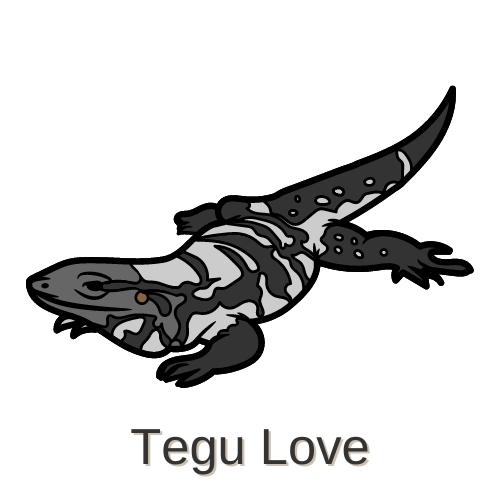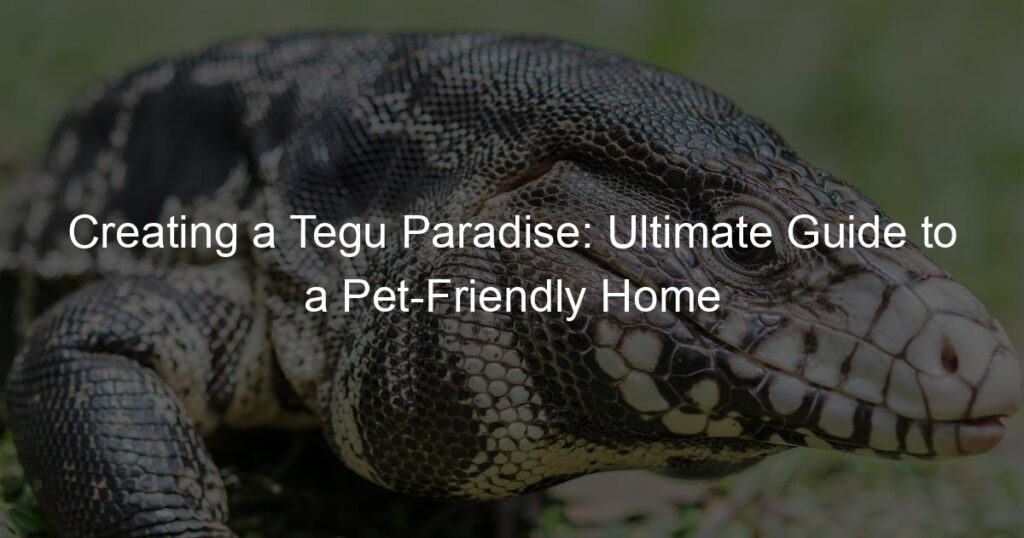
Introduction to Tegu Care at Home
Welcome to the fascinating world of Tegu care at home! Tegus are unique reptiles that require special attention and care. In this guide, we will explore the basics of Tegu care, focusing on understanding their needs and creating a Tegu-friendly environment. Let’s dive in!
-
- Understanding the Needs of Your Tegu
Tegus are intelligent and active reptiles. They require both physical and mental stimulation to stay healthy and happy. This means they need a spacious habitat, a diet rich in nutrients, and plenty of interaction and stimulation.
Like all reptiles, Tegus are ectothermic, meaning they rely on their environment to regulate their body temperature. Therefore, it’s crucial to provide a warm basking spot and a cooler area in their habitat. They also need a humid environment to help with shedding and hydration.
When it comes to diet, Tegus are omnivores. They eat a variety of foods, including fruits, vegetables, and proteins such as insects, eggs, and small mammals. A balanced diet is key to their health and longevity.
-
- Importance of Creating a Tegu-Friendly Environment
Creating a Tegu-friendly environment is not just about meeting their basic needs. It’s about creating a space where your Tegu can thrive and live a fulfilling life. This includes providing them with plenty of space to roam, climb, and burrow, as well as a variety of items to interact with and explore.
It’s also important to maintain the right temperature and humidity levels in their habitat. This can be achieved by using heat lamps, thermostats, and humidifiers. Regular cleaning and maintenance of their habitat is also crucial to prevent the spread of bacteria and parasites.
Remember, a happy Tegu is an active and curious one. By creating a Tegu-friendly environment, you’re not only ensuring their health and wellbeing, but also providing them with the opportunity to express their natural behaviors and live a fulfilling life.
In the following sections, we will delve deeper into the specifics of setting up your Tegu’s habitat, ensuring their comfort, and providing advanced care. Stay tuned!
Setting Up Your Tegu’s Habitat
Creating the perfect habitat for your Tegu is crucial for its health and happiness. Let’s focus on setting up an indoor Tegu habitat.
Indoor Tegu Habitat
Designing an indoor habitat for your Tegu involves three main steps: choosing the right space, setting up the enclosure, and controlling temperature and humidity. Let’s delve into each of these steps.
- Choosing the Right Space
The first step in setting up your Tegu’s indoor habitat is selecting the right space. Tegus are large lizards that require ample room to move around. A space of at least 8 feet by 4 feet is recommended. This space should be in a quiet, low-traffic area of your home to minimize stress for your Tegu.
- Setting Up the Enclosure
Once you’ve chosen the right space, it’s time to set up the enclosure. The enclosure should be secure and escape-proof, as Tegus are known for their ability to climb and dig. A glass terrarium with a secure lid is a good choice. The enclosure should also contain a variety of hiding spots and climbing structures to mimic a Tegu’s natural habitat.
- Temperature and Humidity Control
The final step is controlling the temperature and humidity in your Tegu’s habitat. Tegus thrive in warm temperatures, so aim for a basking spot of around 100-110 degrees Fahrenheit and an ambient temperature of 80-90 degrees. Humidity should be kept at around 60-80%. A combination of heat lamps and humidifiers can help achieve these conditions.
Remember, a well-set habitat is key to your Tegu’s health and happiness. By following these steps, you can create a comfortable and stimulating environment for your pet.
| Aspect | Recommendation |
|---|---|
| Space | At least 8 feet by 4 feet |
| Enclosure | Glass terrarium with secure lid, hiding spots, and climbing structures |
| Temperature | Basking spot: 100-110 degrees Fahrenheit, Ambient: 80-90 degrees |
| Humidity | 60-80% |
Outdoor Tegu Habitat
Creating an outdoor habitat for your Tegu can be a rewarding experience. It allows your pet to enjoy the natural environment while still being safe and secure. Here are some key considerations to keep in mind when setting up an outdoor Tegu habitat.
- Securing the Area
First and foremost, it’s crucial to ensure the outdoor area is secure. Tegus are known for their ability to climb and dig, so you’ll need to build a sturdy enclosure to prevent escapes. A fence of at least 6 feet high is recommended, with a portion buried underground to deter digging. Also, consider adding a secure top to prevent climbing escapes.
- Providing Shelter and Hiding Spots
Tegus are naturally secretive creatures that enjoy having places to hide. Providing ample shelter and hiding spots in the outdoor habitat is essential for their comfort and well-being. You can use natural elements like logs, rocks, and plants to create hiding spots. Additionally, a sheltered area for your Tegu to retreat from the elements is also necessary.
- Temperature and Weather Considerations
Tegus are cold-blooded creatures, which means they rely on their environment to regulate their body temperature. They need a warm spot to bask in the sun, but also a cooler shaded area to retreat when they get too hot. The ideal basking temperature for a Tegu is around 100-110 degrees Fahrenheit. It’s also important to consider the local weather conditions. If you live in a region with cold winters, you’ll need to provide a heated shelter for your Tegu during these months.
By carefully considering these factors, you can create an outdoor habitat that your Tegu will thrive in. Remember, the key to a happy and healthy Tegu is a safe and comfortable environment.
Pet Tegu Comfort: Ensuring a Happy and Healthy Pet
Just like any other pet, Tegus need a comfortable living environment to stay happy and healthy. There are several factors that contribute to this comfort, including a varied diet, regular exercise, and proper handling.
Comfortable Tegu Living Conditions
Let’s delve deeper into each of these factors to understand how they contribute to the overall comfort of your pet Tegu.
-
- Importance of a varied diet
Tegus are omnivores, which means they eat both plants and meat. A varied diet is crucial for their health. They need a mix of fruits, vegetables, and proteins to get all the necessary nutrients. For instance, you can feed them apples, bananas, and peas, along with cooked chicken or turkey. Remember, a healthy Tegu is a happy Tegu!
-
- Regular exercise and stimulation
Just like humans, Tegus need regular exercise to stay fit and healthy. This can be achieved by allowing them to roam around in a safe and secure area. Mental stimulation is equally important. You can use toys or create a stimulating environment with different textures and hiding places. This keeps them active and prevents boredom.
-
- Handling your Tegu
Handling your Tegu correctly is crucial for their comfort. Always support their body fully and avoid quick movements as this can scare them. Remember, the more you handle your Tegu, the more comfortable they will become with you. However, always respect their boundaries and never force interaction.
In conclusion, providing a comfortable living condition for your Tegu involves a balanced diet, regular exercise, and proper handling. By focusing on these aspects, you can ensure a happy and healthy life for your pet Tegu.
Making Home Safe for Tegu
Ensuring a safe environment for your pet Tegu is crucial for its health and happiness. Here are some key steps you can take:
- Eliminating potential hazards:Just like toddlers, Tegus are curious by nature. They love to explore their surroundings. Therefore, it’s important to make sure your home is Tegu-proof. Remove any small objects that your Tegu could swallow and choke on. Also, ensure that there are no sharp objects or toxic plants within your Tegu’s reach. Always supervise your Tegu when it’s out of its enclosure to prevent accidents.
- Introducing your Tegu to other pets:Introducing your Tegu to other pets should be done gradually and with utmost care. Start by allowing them to sniff each other through a barrier. Observe their reactions. If they seem calm and curious, you can proceed to the next step which is supervised face-to-face interaction. Remember, not all pets will get along with each other. So, it’s important to always monitor their interactions.
- Keeping your Tegu’s environment clean:Hygiene is key in preventing diseases. Regularly clean your Tegu’s enclosure to keep it free from bacteria and parasites. Remove any uneaten food, feces, and shed skin promptly. Disinfect the enclosure at least once a week. Also, provide fresh water daily for your Tegu to drink and bathe in.
| Tip | Description |
|---|---|
| Eliminating potential hazards | Remove small, sharp objects and toxic plants. Supervise your Tegu when it’s out of its enclosure. |
| Introducing your Tegu to other pets | Introduce gradually and monitor their interactions. |
| Keeping your Tegu’s environment clean | Clean the enclosure regularly, remove uneaten food and feces promptly, provide fresh water daily. |
By following these tips, you can create a safe and comfortable home for your Tegu. Remember, a happy Tegu is a healthy Tegu!
Tegu Housing Tips: Creating a Tegu-Friendly Home
Creating a home for your pet tegu that is both comfortable and stimulating is crucial for its health and happiness. This section will provide you with essential tips on how to create a tegu-friendly home.
-
- Choosing the Right Substrate
The substrate is the material you place at the bottom of your tegu’s enclosure. It’s important because it helps maintain humidity, provides a place for your tegu to burrow, and contributes to the overall health of your pet. The best substrates for tegus are those that retain moisture well, such as coconut fiber or cypress mulch. Avoid substrates like sand or gravel, as they can cause impaction if ingested.
-
- Providing Climbing and Basking Opportunities
Tegus are active reptiles that enjoy both climbing and basking. Providing branches or rocks for climbing can help keep your tegu physically active and mentally stimulated. Basking spots are also essential for tegus, as they need to warm their bodies to digest food properly. A basking spot should have a temperature of around 100-110 degrees Fahrenheit. Remember to provide both warm and cool areas in the enclosure so your tegu can regulate its body temperature.
-
- Water Sources and Bathing Areas
Water is crucial for tegus. They need it for drinking, soaking, and even defecating. Ensure you provide a large water dish that your tegu can easily get in and out of. The water should be changed daily to prevent the growth of bacteria. Some tegus also enjoy a good soak, so providing a shallow pool or large dish for bathing can be a great addition to their habitat.
In conclusion, creating a tegu-friendly home involves choosing the right substrate, providing climbing and basking opportunities, and ensuring adequate water sources. By following these tips, you can create a home that meets your tegu’s needs and promotes its overall well-being.
| Key Aspect | Recommendation |
|---|---|
| Substrate | Coconut fiber or cypress mulch |
| Climbing and Basking | Provide branches or rocks and a basking spot with a temperature of 100-110 degrees Fahrenheit |
| Water Sources | Provide a large water dish and change the water daily |
Advanced Tegu Pet Care
As a Tegu owner, you must be aware that your pet’s health is of utmost importance. This section will guide you on how to ensure your Tegu gets the best healthcare possible.
Healthcare for Your Tegu
Just like humans, Tegus need regular healthcare to stay fit and healthy. Here are some key points you should consider:
-
- Regular veterinary check-ups
Regular visits to the vet are crucial for your Tegu’s health. Experts recommend a check-up every six months. This helps to detect any potential health issues early and treat them before they become serious. Remember, prevention is always better than cure.
-
- Recognizing signs of illness
As a Tegu owner, you should be able to recognize signs of illness in your pet. These may include loss of appetite, lethargy, changes in skin color, and abnormal behavior. If you notice any of these signs, it’s important to seek veterinary care immediately.
-
- Proper handling and transportation
Handling and transporting your Tegu properly is essential to prevent injury and stress. Always support your Tegu’s body when lifting it and use a secure, ventilated carrier for transportation. Avoid sudden movements and loud noises, which can scare your pet.
Remember, your Tegu’s health is in your hands. By following these guidelines, you can ensure your pet lives a long, happy, and healthy life.
Behavior and Training
Understanding your Tegu’s behavior, training them properly, and dealing with any behavioral issues are all crucial aspects of advanced Tegu pet care. Let’s delve into each of these areas.
-
Understanding Tegu Behavior
Tegus are intelligent and curious creatures. They are known for their active and exploratory nature. Tegus communicate their feelings through their body language. For instance, a relaxed Tegu will have its tongue out, exploring its surroundings. On the other hand, a Tegu that feels threatened may hiss or puff up its body.
Understanding these behaviors can help you better interact with your pet and meet its needs. Remember, a happy Tegu is a healthy Tegu!
-
Training Your Tegu
Training a Tegu requires patience and consistency. Start by handling your Tegu regularly to get it used to human contact. Use positive reinforcement, like treats or praise, when your Tegu behaves well. This will encourage good behavior.
Remember, training should be a fun and rewarding experience for both you and your Tegu. If you’re feeling frustrated, take a break and try again later.
-
Dealing with Behavioral Issues
Like any pet, Tegus can develop behavioral issues. These can range from aggression to refusal to eat. If your Tegu is showing signs of behavioral problems, it’s important to address them promptly.
First, try to identify any changes in your Tegu’s environment that could be causing stress. If you can’t find a cause, or if the behavior continues, consult with a veterinarian or a Tegu expert. They can provide guidance and help you develop a plan to address the issue.
In conclusion, understanding your Tegu’s behavior, training them effectively, and dealing with any behavioral issues are all key to ensuring your Tegu’s happiness and health. Remember, patience and consistency are your best tools when it comes to Tegu care.
Conclusion: The Joy of Tegu Ownership
As we wrap up this comprehensive guide on Tegu ownership, it’s essential to reflect on the responsibilities and appreciate the unique qualities of these fascinating creatures. Owning a Tegu is not just about providing a home; it’s about creating a bond and understanding the joy that comes with it.
-
- Reflecting on the Responsibilities of Tegu Ownership
Being a Tegu owner is a commitment that brings along a set of responsibilities. From setting up a comfortable habitat to ensuring a healthy diet, every aspect requires your attention and care. Tegus are intelligent and active creatures that need mental stimulation and physical exercise. Regular interaction and handling not only keep them happy but also strengthen your bond with them. Remember, a well-cared-for Tegu can live up to 20 years, making this a long-term commitment.
-
- Appreciating the Unique Qualities of Your Tegu
Tegus are truly unique pets with qualities that set them apart. Their intelligence, curiosity, and friendly nature make them fascinating companions. Each Tegu has its own personality, and getting to know them is a rewarding experience. Their distinctive appearance, with a robust body, strong limbs, and a long tail, adds to their charm. Moreover, their ability to recognize their owners and respond to their voice makes the bond with them even more special.
In conclusion, Tegu ownership is a journey filled with learning, joy, and companionship. It’s about understanding and appreciating the unique qualities of these wonderful creatures. It’s about embracing the responsibilities that come with it and finding joy in every moment spent with your Tegu. So, as you embark on this journey, remember that the joy of Tegu ownership lies not just in the destination but also in the journey itself.














